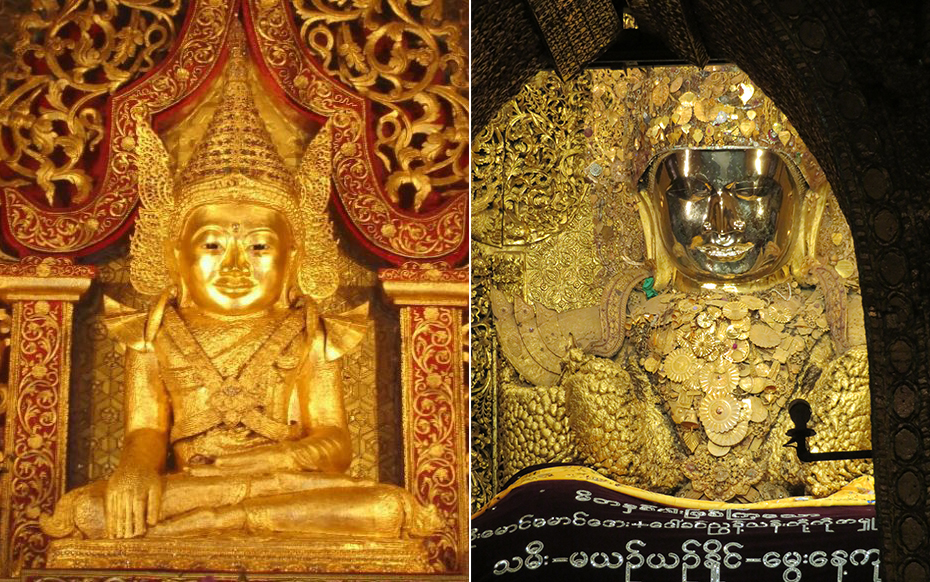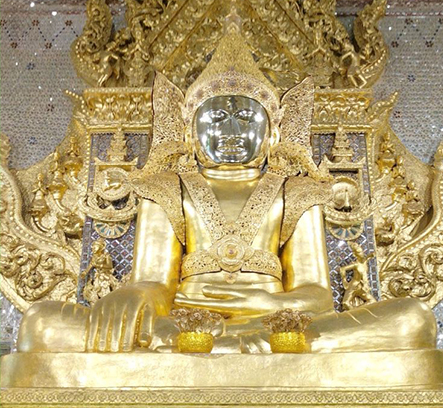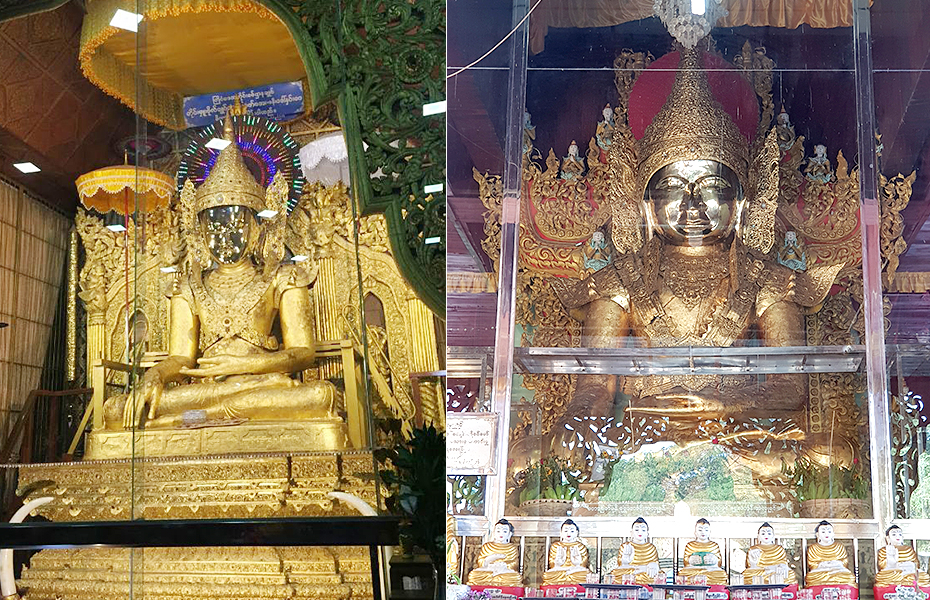Mandalay, a city in northern Myanmar, is famous for the Mahamuni Buddha Temple, where the sacred Mahamuni statue is enshrined. “Mahamuni” is a combination of the words “maha” meaning “great” and “muni” signifying “sage”; together, “Mahamuni” refers to Siddhartha Gautama, the Shakyamuni Buddha who attained great enlightenment. The Mahamuni image in Mandalay is a large gilt bronze statue approximately four meters high. Precious gemstones and thin gold leaves donated by devotees cover the body of the statue to a depth of about six inches. These layers of gold leaves, each thinner than paper, reveal much about the people of Myanmar, their reverence for the Mahamuni Buddha, and the depth of their devotion.
Why, then, do the Myanmar people believe this Mahamuni statue to be sacred? The answer can be found in various sources preserved within the country. The earliest records pertaining to the Mahamuni statue are found in the Sappadanapakarana, an ancient Arakan manu. The Sappadanapakarana gives an account of the mystical events said to have transpired when the Shakyamuni Buddha visited the land of Arakan with his 500 disciples (or arhats) to spread the teachings of Buddhism. One of the stories describes how the Shakyamuni Buddha had successfully conveyed his teachings in the land of Arakan and was about to move on to another region when the Arakan king asked if Buddha’s image could be crafted so that the kingdom would remember his teachings forever. As the Buddha granted this request, the king and his people donated rare and precious gemstones with which to create his image. The Shakyamuni Buddha was delighted to see the result which resembled him so much. He blessed it, naming it “Candasara.”

Perphaps thanks to the blessing of the Shakyamuni Buddha, many mysterious events were said to have been observed after the Mahamuni statue was enshrined in the temple. Allegedly, birds avoid flying over the head of the statue, the trees around the temple bent down toward the statue as if bowing to it, and streams of light shone down on it from above. The Arakanese monarchs also maintained their hold on power without waging war for hundreds of years until the Burmese invasion in the 19th century. They attributed the peace in their kingdom to the protection of the Mahamuni statue. These legends were also passed on to the newly born dynasties in various regions across Myanmar.

The Mahamuni statue is mentioned constantly in the chronicles of the Bagan dynasty of the 12th century and the Konbaung dynasty of the 19th century. The kings of Bagan would send artisans to Arakan to expand the temple where the Mahamuni statue was enshrined or give offerings as a sign of reverence. The kingdoms of various Myanmar tribes such as the Pyu, Shan, and Mon watched for an opportunity to bring the Mahamuni statue of Arakan to their capitals, but these attempts always ended in failure. Only King Bodawpaya of the Konbaung dynasty, known for his endeavors to expand his kingdom’s territory, succeeded in taking the Mahamuni statue out of the Arakan region. He had Prince Thado Minsaw conquer the Arakanese and bring the Mahamuni statue, the oldest and most sacred statue of the Buddha in the region, to Amarapura, then the capital of the Konbaung kingdom. King Mindon of the Konbaung later established Mandalay as the new capital and ordered the statue to be relocated there, where it stands today. The people of Myanmar regard this statue as an incarnation of the Shakyamuni Buddha and proof of the authenticity of the dharma spread from India.
Avatars of Mahamuni modeled upon the original statue can be found in several cities across the country: Sittwe, the capital city of the western Rakhine State; Mawlamyine in the southern Mon State; Pyay, near the ancient Pyu tribe’s city of Sri Ksetra; and Kengtung and Hsipaw in the eastern Shan State. These cities each had important symbolic meaning in Myanmar’s Buddhist history and became economically prosperous. Their Mahamuni statues were created in later times through donations from influential local figures.
The attire of these replica Mahamuni statues differs by region, but the images also share some commonalities, including the decorative tassels arranged in the shape of an X across the upper body, the conical headpiece, and the ornaments on either side of the face reminiscent of butterfly wings. The original Mahamuni statue has half-closed eyelids and a mouth turned up at the edges which combine to form a generous face that seems to faintly smile. The thick lips, rounded philtrum, sharp nose tip, and arched eyebrows harmonize with the smooth contour of the face; this is all reminiscent of features commonly found in statues of the Buddha in Mathura, India dating to the Gupta era. One can recognize in the faces of the reproduced Mahamuni statues that efforts were taken to have them resemble the original as closely as possible. However, while still maintaining its solemnity, Sittwe’s Mahamuni statue gives off a friendlier impression through the localized expression of its face. The pupils, colored black, breathe life into the face so that it conveys the image of the living Buddha, which is considered to be the Sittwe Mahamuni’s greatest feature.

The replica Mahamuni statues in each region may hold less significance than the original in terms of religious aura, symbolic meanings, and historicity, but the people of Myanmar revere them as highly as the statue in Mandalay, considering them each to be sacred avatars of the Shakyamuni Buddha. In all of the temples where a Mahamuni statue is enshrined, every morning the senior monks wash dust from the statue’s face, groom the lips with a large brush, then wipe the face with dry towels offered by devotees. From behind Mahamuni’s brilliant face shines the Myanmar people’s devotion to the Shakyamuni Buddha.
 KOREA FOUNDATION
KOREA FOUNDATION












